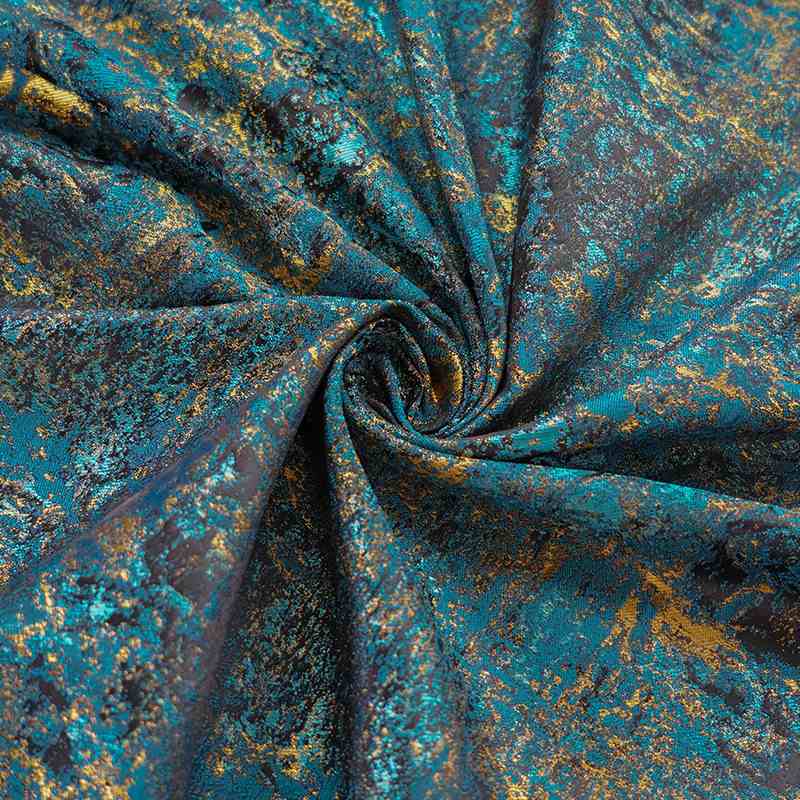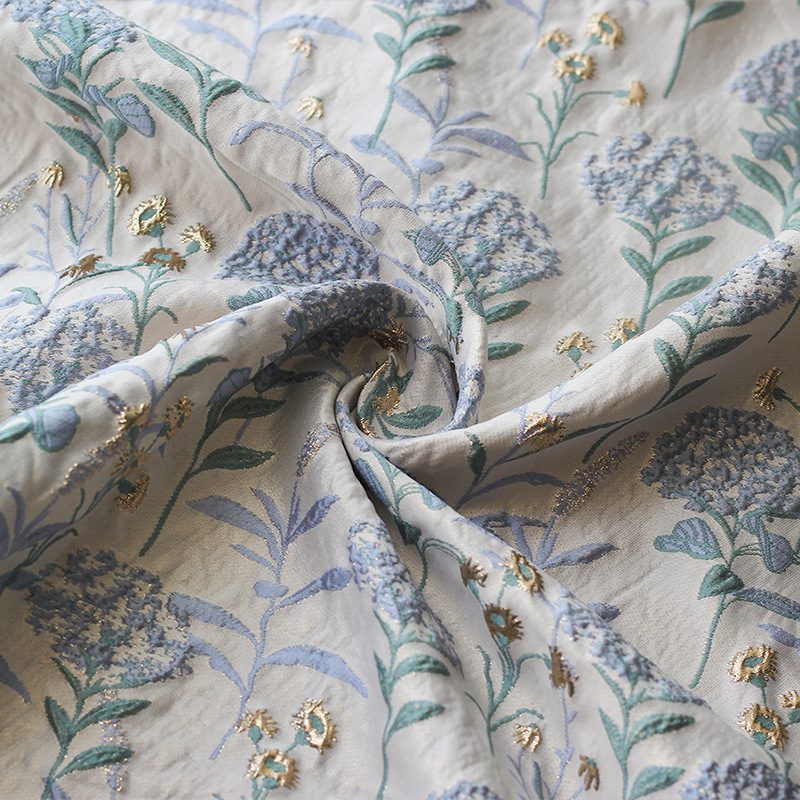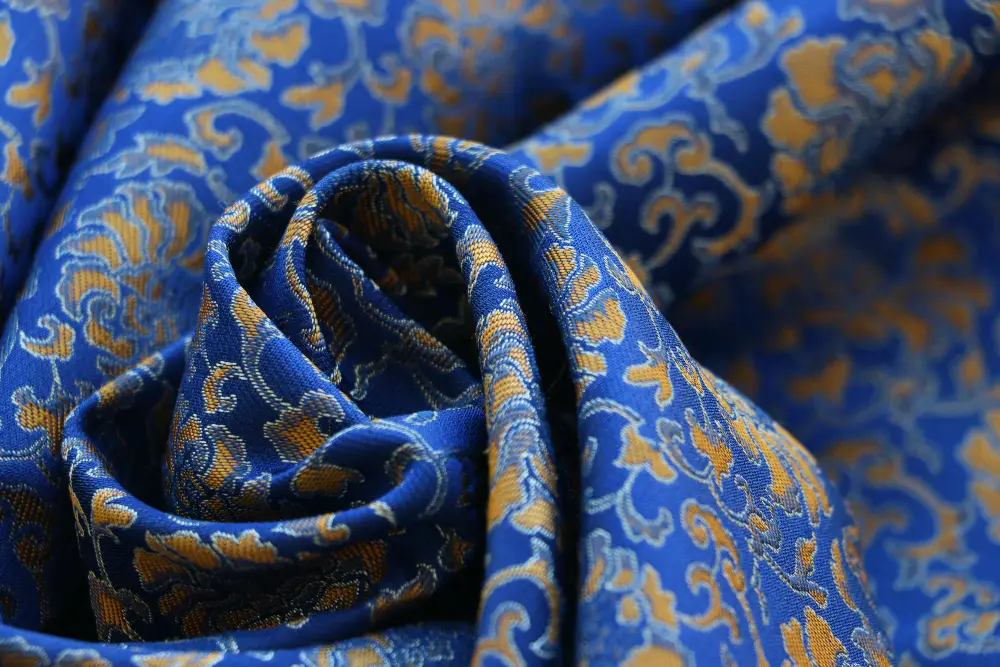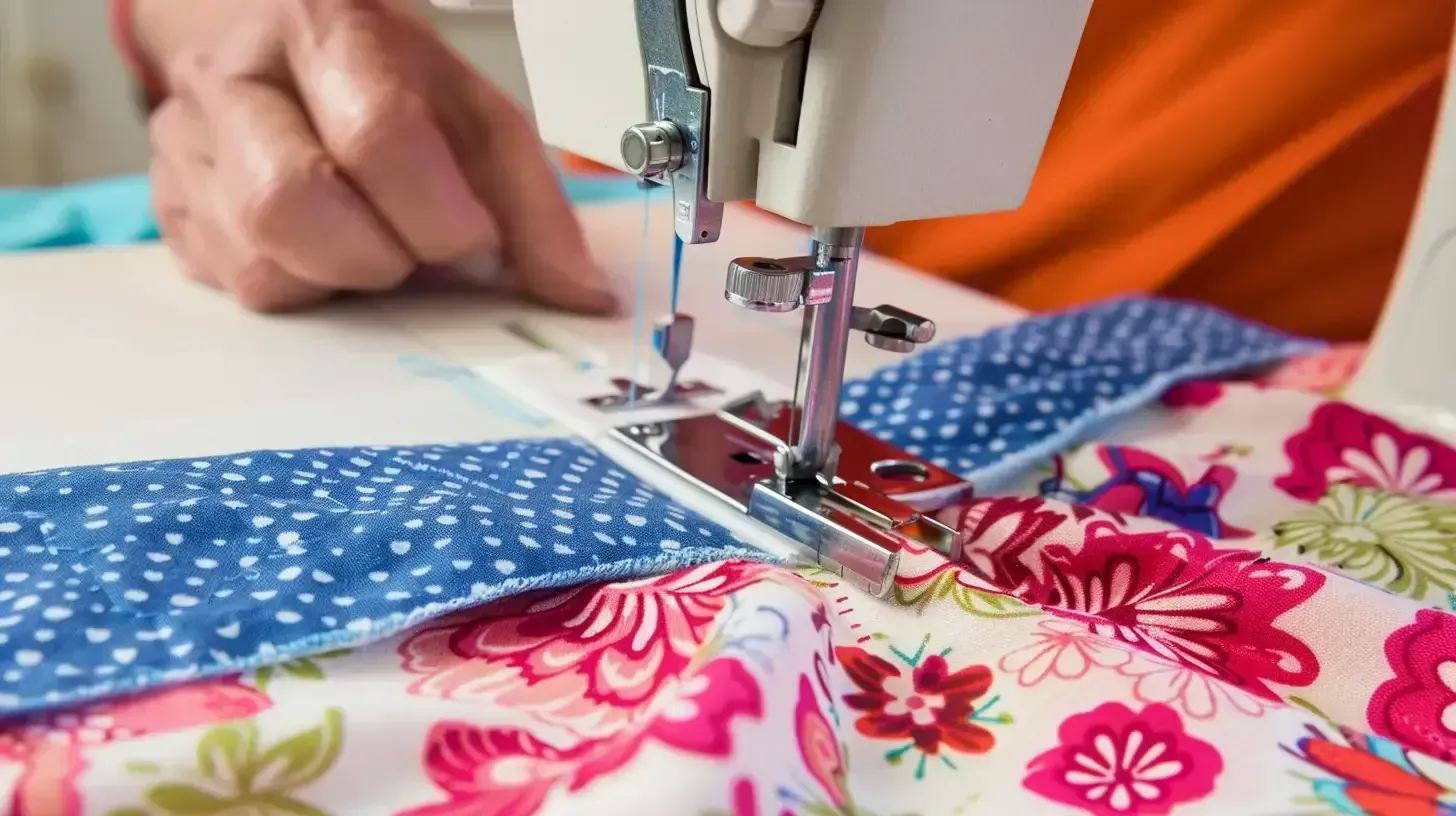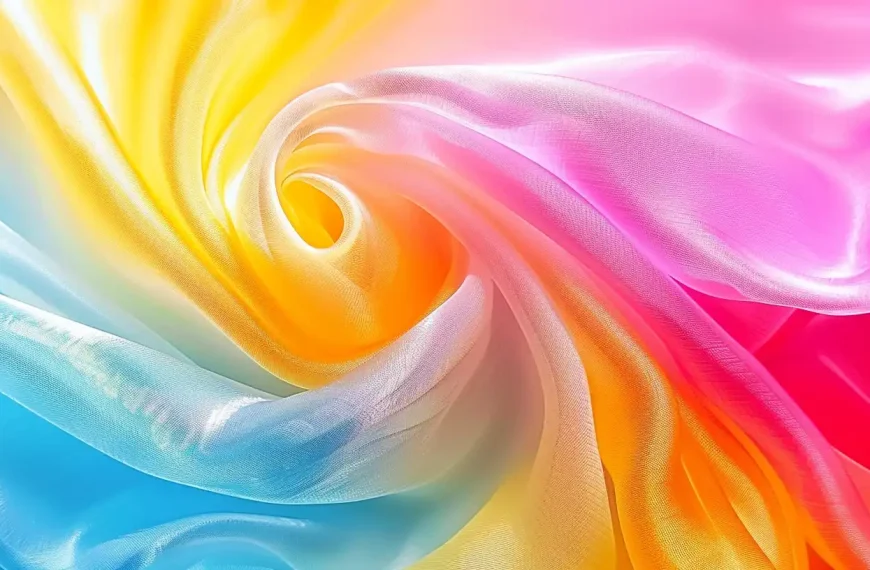Have you ever held a piece of cloth that feels like history and luxury intertwined? If not, you’re probably yet to experience the grandeur of brocade fabric. Brocade is not just any textile. It’s a testament to centuries-old craftsmanship woven with elegance and intricate patterns.
Interestingly, this opulent fabric first appeared in China during the Warring States period between 475–221 BC.
In this blog post, we’ll explore everything you need to know about brocade fabric. From its rich history to its modern applications, we’ll get you covered!
Key Takeaways
- Brocade fabric is a luxurious material with designs woven into it. It can be made using three types of yarns: silk, cotton, wool, or synthetic fibers. It’s known for its rich patterns that add depth and elegance to various items.
- Brocade’s history stretches back to ancient China, around 475–221 BC. It has symbolized wealth and status throughout the ages. Thanks to the invention of the jacquard loom, its production became more efficient in the 19th century.
- Modern brocade comes in different varieties, including silk, cotton, Himru, synthetic, and Zari brocades. Each offers unique attributes.
- Caring for brocade involves gentle spot cleaning without direct ironing or steaming. Professional dry-cleaning is crucial to maintaining the beauty of intricate pieces.
- Natural fiber-based brocades, like silk, are more environmentally friendly than synthetic materials.
What is Brocade Fabric?
Brocade fabric is a luxury textile that stands out. This is because of its intricate patterns woven directly into the fabric. Artisans use three yarns, including a supplementary weft yarn that specifically creates the marvelous designs seen on brocade.
This method results in a richly decorated surface. The patterns seem embroidered but are woven into the fabric.
Materials like silk, wool, cotton, and synthetic fibers are used to make brocade fabric, with all yarns dyed before weaving begins. Due to its complex weaving process and aesthetic appeal, brocade costs more than other woven fabrics.
These characteristics have made it a sought-after material for high-end garments and upholstery. Now, let’s look at how history has shaped the use and perception of brocade fabric over time.
Historical Background of Brocade
During the Warring States period around 475–221 BC, Ancient China witnessed the first known use of brocade. This luxurious fabric quickly symbolized wealth and status among Chinese nobility.
Its intricate patterns woven into the fabric itself required highly skilled artisans to produce. These early examples of brocade showcased the deep cultural appreciation for beauty and craftsmanship in textile production that has persisted through centuries.
As time progressed, the brocade’s allure spread beyond China’s borders. By the 6th century AD, a welcoming audience was found in Byzantium. Here, it adorned royalty and sacred spaces, exemplifying its esteemed role across different cultures.
This fascination continued in Europe during the late Middle Ages and Renaissance. European nobility draped themselves in garments made from silk brocade. The invention of the Jacquard loom in the early 19th century revolutionized the production process. This made it more efficient while maintaining its ornamental charm.
This pivotal moment ensured that brocade remained at the forefront of luxury fashion textiles through innovations in weaving technology.
Manufacturing Process for Brocade Fabric
Creating brocade fabric is a complex but fascinating process. Each step requires careful attention to detail to make the rich patterns that characterize brocade.
- Choosing Materials: The first step involves selecting the base fabric and threads. Silk, cotton, wool, or polyester can serve as the foundation. For decorative elements, weavers may use metallic or differently colored supplementary weft threads.
- Preparing the Loom: Weavers set up a special loom for brocade production. This process includes loading both warp (longitudinal) and weft (lateral) threads according to the desired pattern.
- Designing Patterns: Using jacquard weaving technology, designers create intricate patterns through a punch card system. This system controls which weft threads are raised during weaving to form the design.
- Weaving: The actual weaving combines warp and weft threads on the loom to slowly build up the brocade’s patterned fabric. Careful coordination creates raised areas that form lavish designs.
- Pre-shrinking Fabric: Before adding detailed patterning, weavers pre-shrink the base fabric. This step is crucial. It minimizes potential shrinkage after the raised design is woven into it.
- Inspecting for Quality: After weaving, each piece of brocade undergoes thorough inspections for any flaws or inconsistencies in the pattern or fabric quality.
- Finishing Touches: Finally, apply any necessary finishing processes to enhance the brocade’s appearance and texture. These include trimming loose threads, final dyeing stages, or applying treatments to increase shine or color intensity.
Through these steps, artisans transform basic textile materials into stunning brocade fabrics.
Various Types of Brocade Fabric
Brocade fabric comes in various types, such as silk, cotton, Himru, synthetic, and Zari brocade. Each type offers distinct characteristics that cater to different preferences and needs.
The diverse array of brocade fabrics provides options for various garment styles and occasions.
Silk Brocade
Silk brocade is a luxurious fabric often associated with opulence and high status. It stems from ancient China and the Byzantine Empire. This type of brocade fabric made waves in fashion and decor by becoming a staple for upholstery, draperies, and even historical costumes.
Cotton Brocade
Cotton brocade is a prevalent type of brocade fabric well-known for creating traditional Indian sarees. This luxurious textile exudes elegance and charm. It is a desirable choice for those seeking opulent attire.
Himru Brocade
Originating in the ancient city of Himru, India, Himru brocade is renowned for its intricate designs and patterns. This luxurious fabric often features traditional motifs and symbols that add to its rich cultural heritage.
Synthetic Brocade
Synthetic brocade is crafted using synthetic fibers like rayon or polyester. This makes it a more affordable option compared to natural brocades.
However, it’s important to note that synthetic brocade fabric has a higher environmental impact due to its production process involving synthetic materials.
Zari Brocade
Zari brocade fabric has a long and storied history, particularly within Indian culture. This type of brocade fabric is famous for its sturdiness and decorative nature. It is ideal for draperies, upholstery, various clothing items like sarees and sherwanis, and religious garments depicting Christian subjects.
Brocade Fabric in Modern Usage
Brocade fabric is commonly used for upholstery on furniture, cushions, and throw pillows. It adds an elegant and sophisticated ambiance to any setting. It is also famous for evening wear, including gowns and jackets.
The intricate designs make it a luxurious choice for formal occasions like black-tie events.
Different types of brocade fabric are available today, each catering to various needs. Silk brocade offers a luxurious feel that is perfect for special occasions. Cotton brocade provides a more casual yet stylish option. Himru brocade showcases traditional patterns with gold or silver zari work. Synthetic brocades offer affordable alternatives with modern prints.
Brocade vs. Jacquard: Highlighting the Differences
Now, we will distinguish between brocade and jacquard. They are two terms often used interchangeably but with notable differences.
| Aspect | Brocade | Jacquard |
|---|---|---|
| Definition | A type of richly decorative shuttle-woven fabric, often made with colored silks and sometimes with gold and silver threads. | A broader category of fabric characterized by complex patterns woven into the fabric itself, usually using a Jacquard loom. |
| Origin | Originates from the Italian word “broccato,” meaning embossed cloth. | Named after Joseph Marie Jacquard, who invented the Jacquard loom in the early 19th century. |
| Method | Characterized by using a supplementary weft technique that makes the motifs appear embossed on the fabric. | Utilizes a punch card system in the Jacquard loom to control the weaving of intricate patterns. |
| Usage | Traditionally used in creating upscale, decorative clothing and furnishings. | Used in various textiles, from apparel to upholstery, featuring complex patterns. |
| Environmental Impact | Varies based on the textiles used; silk brocade is the most environmentally friendly option. | Impact depends on the materials used in the Jacquard fabric; the process itself does not inherently impact the environment more than standard weaving. |
| Cost | Typically more expensive due to the intricate designs and aesthetic appeal. | Cost can vary significantly based on the complexity of the design and materials used. |
Proper Care for Brocade Fabric Clothes and Accessories
It’s also crucial to recognize the significance of proper care for brocade fabric clothes and accessories. Here’s how you can ensure the longevity of these exquisite pieces:
- Spot-clean your brocade items using a gentle fabric cleaner and a soft cloth. Remove stains or spills without damaging the delicate material.
- Avoid ironing or steaming brocade fabrics. High heat can cause irreparable damage. Instead, hang them in a steamy bathroom to allow light wrinkles to naturally release.
- Store brocade fabric clothing and accessories in a cool, dry place away from direct sunlight. Prevent fading or discoloration over time.
- For intricate or delicate brocade pieces, seek professional dry cleaning services when necessary. Preserve them without risking damage during at-home laundering.
Impact of Brocade Fabric on the Environment
The brocade fabric’s environmental impact varies according to its textile materials. As the most environmentally friendly option, silk involves natural fibers and is biodegradable.
Conversely, synthetic fibers are harmful to the environment because they cannot decompose and involve chemical processes during production. Thus, it is crucial to consider certifications such as Silk Mark for genuine silk fabrics and the Global Recycle Standard for recycled synthetic fibers when selecting brocade fabric with environmental awareness in mind.
In addition, Woolmark certification signifies sustainable wool fabrics, and American Supima Association (ASA) certification indicates Pima cotton authenticity. These certifications help consumers make eco-friendly choices while enjoying the luxury of brocade fabric.
Conclusion
Unveiling the artistry and history of brocade fabric has left you with an understanding of its elegance and craftsmanship. From its origins in ancient China to its modern-day global presence, brocade fabric is a testament to timeless grandeur.
You now appreciate the practicality of incorporating brocade into your wardrobe, home decor, or upholstery projects. How can you apply this newfound knowledge about brocade’s versatility and impact on your fashion choices or interior design? Embark on integrating brocade into your lifestyle confidently, knowing it adds sophistication while honoring tradition.
This path promises to elevate everyday experiences with a touch of opulence and heritage as you embrace this storied fabric’s rich textures and intricate designs.
Learn more about fabric knowledge from Longan Craft Blog, dive into the fabric world with Longancraft!
FAQs
1. What makes brocade fabric so unique?
Brocade is an elegant luxury fabric. It is well-known for the intricate designs and patterns woven into it, often using silk or a mixture of silk and cotton. Its history stretches back centuries, showcasing craftsmanship in every thread.
2. How is brocade fabric made?
Brocade fabric is woven on looms, including the jacquard loom, which automates the complex process. Threads are sewn to create detailed patterns, sometimes incorporating metallic threads for extra shine.
3. Can I use brocade fabric for everyday clothes?
Traditionally, people use brocade for evening wear, such as gowns and suits. But it can also make stunning blouses or skirts that add elegance to daily outfits.
4. Where does the world’s brocade come from?
Many portions of the world produce brocade, with notable contributions from Chinese silk producers and Indian clothing artisans who often include beautiful embroidery in their designs.
5. Are there different types of brocade fabrics?
Yes! Brocades can vary in materials used—from pure silk to blends with cotton or synthetic materials. They also differ in their patterns, which range from floral motifs to geometric shapes.
6. Why do people choose brocade fabric for special occasions?
Due to its rich textures, elaborate patterns, and connection with luxury and elegance, people often select brocade fabrics for high-end garments, such as coats for black tie events or traditional saris that demand attention.

